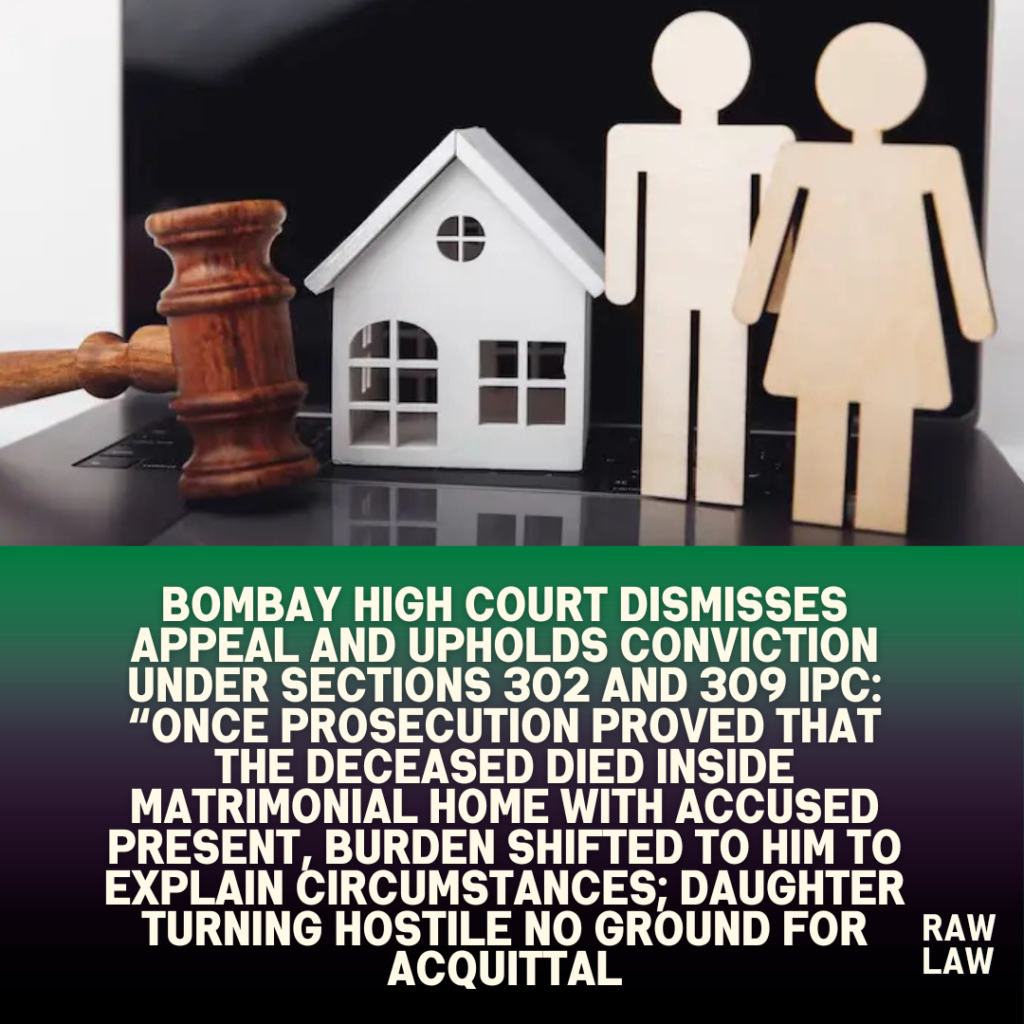Court’s Decision
The Division Bench of the Bombay High Court (Aurangabad Bench) comprising Justices Nitin B. Suryawanshi and Sandipkumar C. More dismissed a criminal appeal filed by the accused challenging his conviction under Sections 302 and 309 of the IPC. The Court affirmed the trial court’s findings that the accused murdered his wife by assaulting her with a hammer and thereafter attempted suicide by cutting his throat with a marble cutter. The conviction and sentences — life imprisonment under Section 302 IPC and two months’ imprisonment under Section 309 IPC — were upheld.
Facts
- The appellant married the deceased Kalpana in 2004; the couple had three children.
- He worked as a mason, while Kalpana was employed as a sweeper in a hospital.
- The prosecution alleged that the accused frequently suspected his wife’s chastity, leading to quarrels.
- On the night of 4/5 October 2017, their daughter Netal informed her grandmother (PW-2) that the accused struck Kalpana on the head with a hammer and then attempted to slit his throat.
- Both were found injured at the scene; Kalpana later succumbed to head injuries in hospital.
- The trial court convicted the accused in Sessions Case No. 26 of 2018 (06.11.2019).
Issues
- Whether conviction could be sustained despite the daughter (alleged eyewitness) turning hostile.
- Whether the prosecution established a complete chain of circumstances consistent only with the guilt of the accused.
- Whether Section 106 of the Evidence Act could be invoked to draw adverse inference against the accused.
- Whether the conviction under Section 309 IPC for attempted suicide was sustainable.
Appellant’s Arguments
- The sole alleged eyewitness (Netal, PW-5) did not support the prosecution; her Section 164 CrPC statement could not be treated as substantive evidence.
- Medical evidence was inconclusive: hammer not shown to the doctor; injuries not opined as “sufficient to cause death in ordinary course.”
- Evidence of PW-2 (mother of deceased) and PW-6 (brother) was hearsay.
- The defence suggested possibilities of accidental injury or intervention by a third person.
- Invoked precedents including Sharad Birdhichand Sarda v. State of Maharashtra (five golden principles of circumstantial evidence) and Shankarlal v. State of Maharashtra, contending chain of circumstances was incomplete.
Respondent’s Arguments
- Death occurred inside the matrimonial home; only the accused and deceased were present.
- Bloodstained hammer and marble cutter were seized from the spot; forensic analysis confirmed presence of human blood.
- Medical evidence confirmed fatal head injury by hard blunt object.
- The accused attempted suicide, evidencing guilty mind.
- Section 106 Evidence Act applied — the accused failed to offer a plausible explanation for his wife’s fatal injury.
- Cited Balvir Singh v. State of Uttarakhand (SC, 2024) and Vijaya Singh v. State of Uttarakhand (SC, 2024) in support.
Analysis of the Law
- Section 164 CrPC statement: Court clarified it was not treated as substantive evidence but only for corroboration/contradiction.
- Circumstantial Evidence: Reiterated principles from Sharad Sarda requiring complete chain pointing only to guilt of accused.
- Section 106 Evidence Act: Once prosecution proved that the deceased died inside matrimonial home with accused present, the burden shifted to him to explain circumstances. Failure to do so constituted an additional link.
- Motive: Accused’s repeated suspicion of wife’s fidelity established motive, though motive is not indispensable if chain of circumstances is otherwise complete.
- Section 309 IPC: Doctor’s evidence of self-inflicted throat injury sustained by accused supported conviction for attempt to suicide.
Precedent Analysis
- Sharad Birdhichand Sarda v. State of Maharashtra (1984) 4 SCC 116 – Five golden principles of circumstantial evidence reaffirmed.
- Shankarlal v. State of Maharashtra (1981) 2 SCC 35 – Circumstances must exclude every hypothesis except guilt.
- Balvir Singh v. State of Uttarakhand (2024 SC) – Failure to explain death within matrimonial home creates adverse inference.
- Nagendra Sah v. State of Bihar (2021) 10 SCC 725 – Section 106 does not dilute prosecution’s burden but supplements it.
- Murlidhar v. State of Rajasthan (2005) 11 SCC 133 – Burden on prosecution remains; accused’s silence can be an additional link.
Court’s Reasoning
- The hostile testimony of the daughter did not demolish the case, as other evidence (forensic, medical, seizure, and surrounding circumstances) established guilt.
- Presence of hammer and marble cutter with human blood, coupled with medical findings, linked accused to the crime.
- The accused’s inconsistent and improbable defences (unconsciousness, third-person assault) were rejected.
- The suicide attempt corroborated his consciousness of guilt.
- “The appellant has failed to give acceptable explanation as to how his wife sustained such fatal injury. His failure itself is an additional link in the chain of circumstantial evidence.”
Conclusion
The High Court upheld the conviction and dismissed the appeal. The accused remains convicted under Sections 302 and 309 IPC, sentenced to life imprisonment with fine for murder and two months’ RI with fine for attempted suicide.
Implications
- Reinforces that in matrimonial home deaths, the husband must provide a plausible explanation; silence or false defence strengthens prosecution.
- Clarifies limits of Section 164 CrPC statements, usable only for corroboration/contradiction.
- Confirms that circumstantial evidence, if forming a complete chain, can sustain conviction even if eyewitnesses turn hostile.



